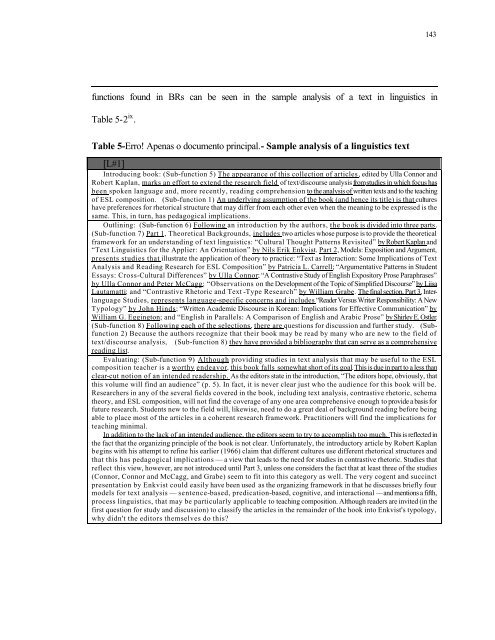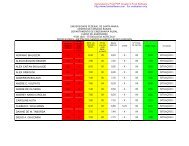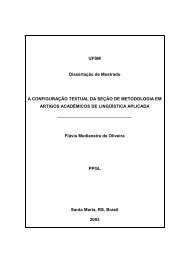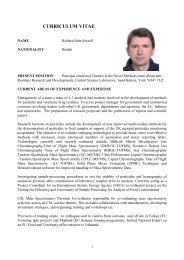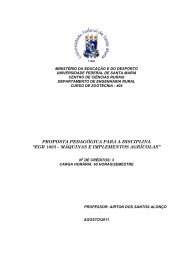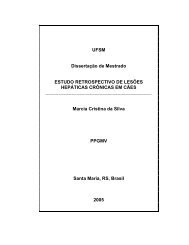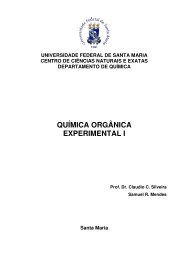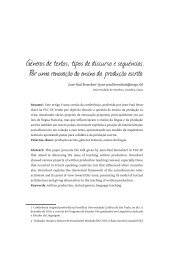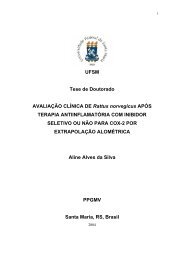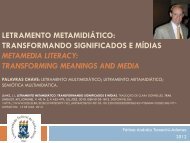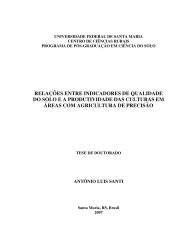universidade federal de santa catarina pós-graduação em letras ...
universidade federal de santa catarina pós-graduação em letras ...
universidade federal de santa catarina pós-graduação em letras ...
You also want an ePaper? Increase the reach of your titles
YUMPU automatically turns print PDFs into web optimized ePapers that Google loves.
143functions found in BRs can be seen in the sample analysis of a text in linguistics inTable 5-2 ix .Table 5-Erro! Apenas o documento principal.- Sample analysis of a linguistics text[L#1]Introducing book: (Sub-function 5) The appearance of this collection of articles, edited by Ulla Connor andRobert Kaplan, marks an effort to extend the research field of text/discourse analysis from studies in which focus hasbeen spoken language and, more recently, reading comprehension to the analysis of written texts and to the teachingof ESL composition. (Sub-function 1) An un<strong>de</strong>rlying assumption of the book (and hence its title) is that cultureshave preferences for rhetorical structure that may differ from each other even when the meaning to be expressed is thesame. This, in turn, has pedagogical implications.Outlining: (Sub-function 6) Following an introduction by the authors, the book is divi<strong>de</strong>d into three parts.(Sub-function 7) Part 1, Theoretical Backgrounds, inclu<strong>de</strong>s two articles whose purpose is to provi<strong>de</strong> the theoreticalframework for an un<strong>de</strong>rstanding of text linguistics: “Cultural Thought Patterns Revisited” by Robert Kaplan and“Text Linguistics for the Applier: An Orientation” by Nils Erik Enkvist. Part 2, Mo<strong>de</strong>ls: Exposition and Argument,presents studies that illustrate the application of theory to practice: “Text as Interaction: Some Implications of TextAnalysis and Reading Research for ESL Composition” by Patricia L. Carrell; “Argumentative Patterns in Stu<strong>de</strong>ntEssays: Cross-Cultural Differences” by Ulla Connor; “A Contrastive Study of English Expository Prose Paraphrases”by Ulla Connor and Peter McCagg; “Observations on the Development of the Topic of Simplified Discourse” by LiisaLautamatti; and “Contrastive Rhetoric and Text -Type Research” by William Grabe. The final section, Part 3, InterlanguageStudies, represents language-specific concerns and inclu<strong>de</strong>s “Rea<strong>de</strong>r Versus Writer Responsibility: A NewTypology” by John Hinds; “Written Aca<strong>de</strong>mic Discourse in Korean: Implications for Effective Communication” byWilliam G. Eggington; and “English in Parallels: A Comparison of English and Arabic Prose” by Shirley E. Ostler.(Sub-function 8) Following each of the selections, there are questions for discussion and further study. (Subfunction2) Because the authors recognize that their book may be read by many who are new to the field oftext/discourse analysis, (Sub-function 8) they have provi<strong>de</strong>d a bibliography that can serve as a comprehensivereading list.Evaluating: (Sub-function 9) Although providing studies in text analysis that may be useful to the ESLcomposition teacher is a worthy en<strong>de</strong>avor, this book falls somewhat short of its goal. This is due in part to a less thanclear-cut notion of an inten<strong>de</strong>d rea<strong>de</strong>rship. As the editors state in the introduction, “The editors hope, obviously, thatthis volume will find an audience” (p. 5). In fact, it is never clear just who the audience for this book will be.Researchers in any of the several fields covered in the book, including text analysis, contrastive rhetoric, sch<strong>em</strong>atheory, and ESL composition, will not find the coverage of any one area comprehensive enough to provi<strong>de</strong> a basis forfuture research. Stu<strong>de</strong>nts new to the field will, likewise, need to do a great <strong>de</strong>al of background reading before beingable to place most of the articles in a coherent research framework. Practitioners will find the implications forteaching minimal.In addition to the lack of an inten<strong>de</strong>d audience, the editors se<strong>em</strong> to try to accomplish too much. This is reflected inthe fact that the organizing principle of the book is not clear. Unfortunately, the introductory article by Robert Kaplanbegins with his att<strong>em</strong>pt to refine his earlier (1966) claim that different cultures use different rhetorical structures andthat this has pedagogical implications –– a view that leads to the need for studies in contrastive rhetoric. Studies thatreflect this view, however, are not introduced until Part 3, unless one consi<strong>de</strong>rs the fact that at least three of the studies(Connor, Connor and McCagg, and Grabe) se<strong>em</strong> to fit into this category as well. The very cogent and succinctpresentation by Enkvist could easily have been used as the organizing framework in that he discusses briefly fourmo<strong>de</strong>ls for text analysis –– sentence-based, predication-based, cognitive, and interactional –– and mentions a fifth,process linguistics, that may be particularly applicable to teaching composition. Although rea<strong>de</strong>rs are invited (in thefirst question for study and discussion) to classify the articles in the r<strong>em</strong>ain<strong>de</strong>r of the hook into Enkvist's typology,why didn't the editors th<strong>em</strong>selves do this?


